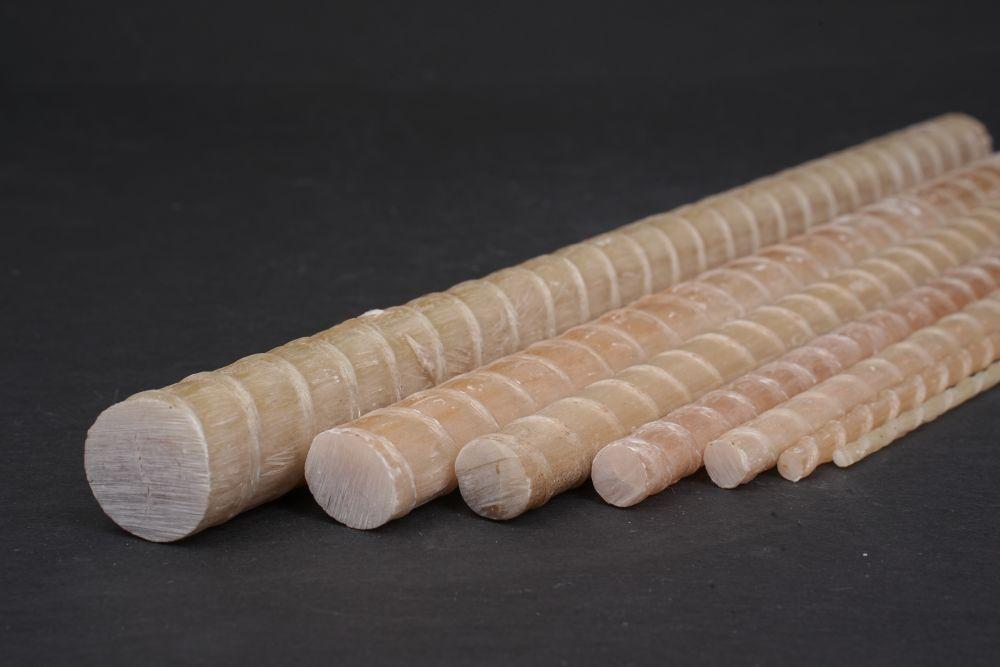- +919659859896
- india@mrg-composites.com
- We Ship Worldwide
- Download Company Profile
ISO 9001:2015 Certified

Lighter
In the world of modern construction, innovation drives efficiency, durability, and sustainability. Among these advancements, GFRP (Glass Fiber Reinforced Polymer) Rebar has emerged as a game-changer. Known for its exceptional strength and lightweight properties, GFRP rebar addresses traditional challenges in construction while setting a new benchmark for performance.
What Are the Problems Caused by Heavy Construction Materials?
Construction has relied on heavy materials like steel and concrete for centuries. While these materials provide strength, they also pose several challenges:
- Excessive Load on Structures
Heavy materials increase the dead load of buildings, bridges, and other infrastructure. This additional weight places stress on foundations, requiring complex designs and increasing material usage. - Higher Transportation Costs
Transporting heavy materials requires more fuel, larger vehicles, and multiple trips, driving up logistical expenses. - Slower Construction Processes
Heavy materials demand specialized handling equipment, additional labor, and extended installation time, delaying project timelines. - Limited Seismic Performance
In earthquake-prone areas, the weight of traditional materials amplifies structural risks, making buildings more vulnerable to damage.
These problems underscore the urgent need for lightweight construction materials that simplify processes without compromising performance.
The Advantages of Lightweight Construction Materials
Switching to lightweight materials in construction offers transformative benefits that redefine efficiency and sustainability:
- Simplified Design
Lighter materials reduce the stress on foundations, allowing for more straightforward and cost-effective designs. - Lower Transportation and Handling Costs
Lightweight materials are easier to transport and require less heavy machinery during installation, significantly cutting costs. - Faster Installation
With fewer handling challenges, lightweight materials accelerate project timelines and reduce labor requirements. - Improved Structural Safety
Buildings and infrastructure made with lightweight materials exhibit better seismic resistance, reducing the likelihood of catastrophic failure. - Energy Efficiency
Many lightweight materials provide superior thermal insulation, making buildings more energy-efficient and sustainable.
What Is GFRP Rebar?
GFRP rebar is a cutting-edge composite material crafted from glass fibers embedded in a high-performance polymer matrix. It is designed to replace traditional steel rebar in construction, offering the same, if not better, performance with a fraction of the weight.
Unique Characteristics of GFRP Rebar
- Lightweight: GFRP Rebar is ¼ lighter than steel,It takes less energy for transportation.
- Corrosion-Free: Unlike steel, GFRP rebar does not rust, even in marine or chemically aggressive environments.
- High Strength-to-Weight Ratio: GFRP Rebar is two times stronger than traditional steel reinforcement bars. GFRP Rebar makes the construction stronger, and provides light weight to construction.
- Non-Magnetic and Non-Conductive: Perfect for applications requiring electromagnetic neutrality, such as MRI facilities.

Advantages of GFRP Rebar in Construction
- Ease of Handling
The lightweight nature of GFRP rebar makes it easy to transport, carry, and position during construction, reducing reliance on heavy machinery. - Corrosion Resistance
GFRP rebar is immune to rust, ensuring longer-lasting structures and reducing maintenance costs. This is especially beneficial for projects exposed to water or chemicals, such as bridges and coastal infrastructure. - Enhanced Durability
The durability of GFRP rebar extends the lifespan of structures, even in harsh environments, providing long-term value. - Eco-Friendly
With a lower carbon footprint than steel and fewer maintenance needs, GFRP rebar supports sustainable construction practices. - Adaptability
Its unique properties make GFRP rebar suitable for various applications, from bridges and high-rises to precast elements and marine structures.
How GFRP Rebar Supports Lightweight Construction
The lightweight properties of GFRP rebar are revolutionizing how structures are designed and built:
- Bridge Construction
GFRP rebar minimizes dead loads, enabling longer spans and reducing the need for heavy foundations. This leads to cost-effective and durable bridge designs. - Marine Applications
In marine environments, GFRP rebar’s light weight and corrosion resistance ensure structures withstand the test of time without adding excessive load. - Seismic-Resilient High-Rises
In earthquake-prone regions, GFRP rebar reduces the overall weight of buildings, enhancing stability and reducing the risk of structural failure. - Precast Concrete Elements
The lightness of GFRP rebar allows for easier transportation and faster installation of precast components, cutting down construction timelines.
GFRP Rebar vs. Steel Rebar for Lightweight Construction
When it comes to lightweight construction, GFRP rebar outperforms traditional steel rebar in several critical areas. GFRP rebar is up to 75% lighter, making transportation, handling, and installation significantly easier and more cost-effective compared to steel, which is much heavier and requires specialized equipment. Unlike steel, GFRP rebar does not corrode, even in harsh environments such as marine or chemical-exposed areas, ensuring a longer lifespan and lower maintenance costs. Its high strength-to-weight ratio delivers excellent tensile strength without the burden of added weight, while its non-magnetic and non-conductive properties make it ideal for sensitive applications like MRI facilities or electrical substations. Additionally, GFRP rebar is more environmentally friendly, producing fewer carbon emissions during manufacturing and aligning with sustainable construction goals. By choosing GFRP rebar, contractors can achieve durable, efficient, and cost-effective solutions for modern construction projects, especially those requiring lightweight materials.
Why GFRP Rebar is the Future of Lightweight Construction
As the construction industry moves toward more sustainable and efficient practices, GFRP rebar stands out as the ultimate lighter construction material. Its lightweight nature simplifies logistics and installation, while its corrosion resistance and durability enhance the lifespan of structures.
Whether you’re building bridges, marine structures, or high-rises, GFRP rebar offers unparalleled benefits. By replacing traditional materials like steel with GFRP, you not only improve project efficiency but also contribute to a more sustainable future for the construction industry.

